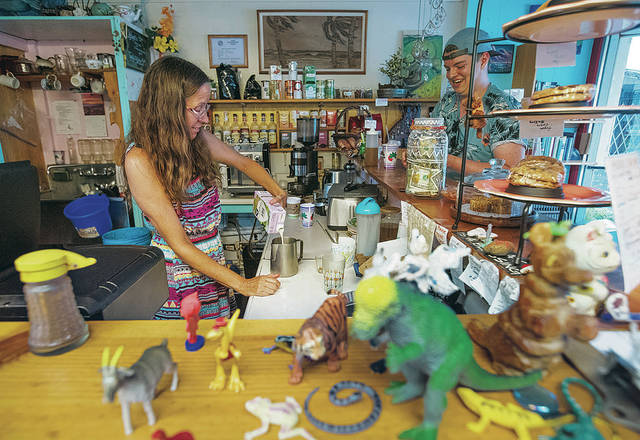State leaders should be devising plans now to help volcano-affected businesses recover

CINDY ELLEN RUSSELL / CRUSSELL@STARADVERTISER.COM
Chris Gagnes prepared a beverage for a customer at Sirius Coffee Connection in Pahoa, June 7. Business has fluctuated but has definitely been slower since so many regular customers have lost their homes to lava.
Seething and erupting since 1983, Hawaii’s Kilauea volcano is the world’s most active, according to geologists.
For economists, Kilauea may be one of the most lucrative.
The National Park Service estimates that last year, Hawaii Volcanoes National Park’s 2 million visitors brought in $166 million in spending to the area.
It supported 2,020 jobs and $78.8 million in labor income. It draws more visitors than Pearl Harbor’s USS Arizona Memorial. It is a flat-out money maker.
Almost constant eruptions since May forced the park to close. Volcanologists cannot predict when the eruptions will cease, so park officials don’t know when the park’s major attractions can open.
There is also a catch, explains Bill Walter, Big Island Chamber of Commerce president.
Don't miss out on what's happening!
Stay in touch with breaking news, as it happens, conveniently in your email inbox. It's FREE!
The staggering amount of lava or magma pouring into the ocean on the Big Island used to be up at Kilauea summit. It is gone, so it isn’t holding up the summit, so the summit is falling.
>> Explosion shakes Kilauea’s summit
>> Lava has blocked road access to favorite shoreline sites
>> Volcanic activity destroying marine and forest preserves
RELATED PHOTOS AND VIDEOS
>> Live webcams from Hawaii island
>> Fissure 8 channel transports ‘lava boats’
>> Lava on Moku Street in Leilani Estates, June 21
>> Vigorous lava flow from fissure 8 to ocean, June 19 Opens in a new tab
>> Gas plume above Halemaumau Crater, June 18 Opens in a new tab
>> Hawaii National Guard lava river flyby, June 16 Opens in a new tab
>> Kalapana Night Market provides needed lava break for residents, June 16
>> Newly opened center is a one-stop shop for Kilauea disaster survivors on Hawaii island, June 15
>> Dramatic footage from Kilauea’s most active fissure: No. 8, June 15
>> Pahoa business owners talk about drop in business, June 14
COMPLETE KILAUEA COVERAGE
>> Star-Advertiser volcano coverage
>> Kilauea Volcano YouTube playlist
“The magma has gone away, the entire area is dropping, without that support, it causes big cracks throughout the park,” Walter said in an interview.
Somewhat ominously, the park staff at Jaggar Museum moved its collection of artifacts and exhibit features from the damaged museum.
The move “really drives home how much has changed in the park and at the summit of Kilauea since late April, and how much damage the recent activity has done,” said a park spokeswoman.
Meanwhile downslope, the eruptions and 2,000- degree lava flows have forced more than 1,000 displaced residents to seek emergency help: temporary tent cities have been set up and there is much worry with all the displacements.
With so much suffering going on, it may seem callous to think of taxes, but without government money, nothing will get fixed.
Hawaii County faces a $5 million shortfall for the 2018-19 fiscal year, police Assistant Chief Marshall Kanehailua said in a West Hawaii Today report last week. County overtime is soaring, businesses are selling, stores are closed.
The 6,000 acres covered in lava used to be where 500 taxpaying homes sat.
I asked House Speaker Scott Saiki if now is the time for the state Legislature to come back into special session and start making grants.
Saiki urged caution — pointing out that Gov. David Ige has used his emergency declaration powers to designate $12 million in state dollars for the Big Island county government emergency.
Saiki and a legislative delegation toured the devastation earlier this month and asked officials how much they would need.
“The response was it is too early to tell. They said they would have a better idea in August,” Saiki said in an interview.
If Ige is able to release state funds and the state continues to run a healthy surplus, the Legislature may not need to reconvene, Saiki said.
State Rep. Joy San Buenaventura, who represents Puna, said more needs to be done.
“Right now the tourist hub of Volcano is closed for business — there are at least 12 miles along the highway that once had turn-offs to Mauna Loa’s koa forest and endangered birds, to trails and to picnic/campgrounds — that are all closed and thus, all transient accommodations, restaurants, cafes, gift shops and other tourist venues in the small town of Volcano are dying,” she said.
There also are other less-obvious problems. Businessman Walter said local farms growing papaya, tropical flowers and other crops have been damaged, isolated by lava flows or ruined by toxic fumes. This comes as many in the region took out loans after the hurricane damaged the Puna area four years ago.
“The bad news is the debt,” Walter said. “It is going to be a matter of getting the farms back into business.”
Besides volcanoes, the Big Island has lots of vacant, fertile good agricultural land. Much of it needs to be cleared and made available without all the red tape.
Now would be the time for state leaders to quickly start making post-eruption plans to help the farmers help Hawaii Island get back to business.
Richard Borreca writes on politics on Sundays. Reach him at 808onpolitics@gmail.com.



